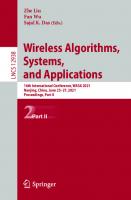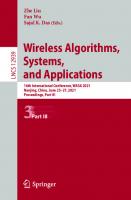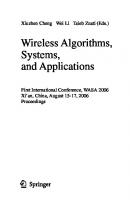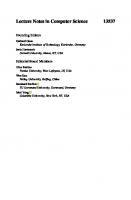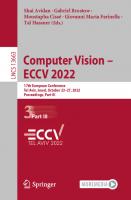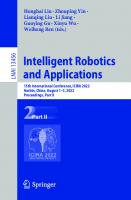Wireless Algorithms, Systems, and Applications: 17th International Conference, WASA 2022, Dalian, China, November 24–26, 2022, Proceedings, Part III (Lecture Notes in Computer Science) 3031192109, 9783031192104
The three-volume set constitutes the proceedings of the 17th International Conference on Wireless Algorithms, Systems, a
155 93 48MB
English Pages 692 [679] Year 2022
Table of contents :
Preface
Organization
Contents – Part III
Theoretical Frameworks and Analysis of Fundamental Cross-Layer Protocol and Network Design and Performance Issues
DC-Gossip: An Enhanced Broadcast Protocol in Hyperledger Fabric Based on Density Clustering
1 Introduction
2 Related Works and Background
2.1 Communication Performance
2.2 Broadcast Protocal
3 Method Analysis
4 Design of DC-Gossip
4.1 Initial Dissemination Structure
4.2 Push Dissemination
4.3 Responding to Dynamic Changes of Network
4.4 Timed Re-clustering
5 Evaluation
5.1 Experimental Setup
5.2 Comparison Results
6 Conclusion
References
A Time Utility Function Driven Scheduling Scheme for Managing Mixed-Criticality Traffic in TSN
1 Introduction
2 System Model and Problem Description
3 Proposed Scheduling Scheme
3.1 Stream Scheduling Constraints
3.2 Sieving Strategy for Scheduling Periodic Streams
3.3 Online Algorithm for Scheduling Aperiodic Streams
4 Experimental Evaluation
5 Conclusion
References
Distributed and Localized Algorithm Design and Analysis
Distributed Anti-manipulation Incentive Mechanism Design for Multi-resource Trading in Edge-Assistant Vehicular Networks
1 Introduction
2 System Model
2.1 Network Model
2.2 Reverse Auction Framework
3 Problem Formulation
4 Faithful Distributed Multi-resource Trading Mechanism
4.1 The DRCA Mechanism
4.2 Proof of Properties
5 Simulation Results
5.1 Allocation Efficiency
5.2 System Overhead
6 Conclusion
References
Information and Coding Theory for Wireless Networks
Communication Optimization in Heterogeneous Edge Networks Using Dynamic Grouping and Gradient Coding
1 Introduction
2 System Model and Problem Formulation
3 Dynamic Grouping and Heterogeneity-Aware Gradient Coding
3.1 Static Grouping and Dynamic Grouping
3.2 Dynamic Grouping and Heterogeneity-Aware Gradient Coding
3.3 DGHGC Complexity
4 Experiments
4.1 Experiment Settings
4.2 Analysis of Results
5 Conclusion
References
Design on Rateless LDPC Codes for Reliable WiFi Backscatter Communications
1 Introduction
2 Preliminaries
2.1 Backscatter Communication Based on WiFi
2.2 LDPC Code and Rateless Code
3 System Design
3.1 Index Matrix
3.2 Generator Matrix
3.3 Rateless LDPC Encoder
3.4 Rateless LDPC Decoder
4 Performance Evaluation
5 Discussion
6 Conclusion
References
Design of Physical Layer Coding for Intermittent-Resistant Backscatter Communications Using Polar Codes
1 Introduction
2 Preliminary Knowledge
2.1 Polar Codes
2.2 Convolutional Codes
2.3 Fountain Code
2.4 SCL Algorithm
3 Coding Design
3.1 Transmitter
3.2 Receiver
3.3 Algorithm Design
4 Performance Analysis
5 Conclusion
References
MEBV: Resource Optimization for Packet Classification Based on Mapping Encoding Bit Vectors
1 Introduction
2 Related Work
2.1 BV-Based Packet Classification
2.2 Motivation
3 Proposed Scheme
3.1 Mapping Encoding Bit Vector (MEBV) SCHEME
3.2 HRME: High Reuse Field Mapping Encoding
3.3 PMME: Prefix Matching Field Mapping Encoding
3.4 WMME: Wildcard Matrix Field Mapping Encoding
3.5 RMME: Range Matching Field Mapping Encoding
3.6 Packet Rule Matching
3.7 Hash Collision Resolution
4 Experimental Results and Analysis
4.1 Space Complexity
4.2 Throughput
4.3 Resource Consumption
5 Conclusion
References
NT-RP: A High-Versatility Approach for Network Telemetry Based on FPGA Dynamic Reconfigurable Pipeline
1 Introduction
2 Related Work
3 Architecture and Methodology of NT-RP
3.1 Overview
3.2 Distributed NTM Cyclic Storage Strategy
3.3 Telemetry Function Integration Mechanism
3.4 NT-RP Based Network Telemetry Methods
4 Performance Evaluation
5 Conclusion
References
An Effective Comprehensive Trust Evaluation Model in WSNs
1 Introduction
2 Related Works
3 Proposed Comprehensive Trust Assessment Model
3.1 Network Topology Model and Assumptions
3.2 Direct Trust Model
3.3 Indirect Trust Model
3.4 Comprehensive Trust Evaluation Model
4 Simulation Experiment and Performance Analysis
5 Conclusion
References
Precise Code Clone Detection with Architecture of Abstract Syntax Trees
1 Introduction
2 Background
3 Methodology
3.1 Parsing and Calculating
3.2 Abstract Syntax Tree Filtering
3.3 Eliminate Duplicate Clone Pairs
4 Experimental Setup
4.1 Research Questions
4.2 Dataset and Configuration
5 Experimental Results and Analyses
5.1 Recall
5.2 Precision
5.3 Optimal Range
5.4 Execution Time
6 Discussion
7 Related Work
8 Conclusion
References
Multi-view Pre-trained Model for Code Vulnerability Identification
1 Introduction
2 Methodology
2.1 Structural Information
2.2 Structure-Aware Self-attention Encoder
2.3 Multi-view Contrastive Learning
2.4 Training Loss
3 Experiments
3.1 Experimental Setup
3.2 Experimental Results
3.3 Ablation Study
4 Related Work
5 Conclusion
References
Localization
Discover the ICS Landmarks Based on Multi-stage Clue Mining
1 Introduction
2 Background and Motivation
2.1 Clues in Banner
2.2 Clues in HTML
2.3 ICS Geolocation Based on Clues
3 Location-Indicating Clue Miner
3.1 Banner Grabber
3.2 Banner Clue Miner
3.3 Html Clue Miner
3.4 Clue Normalization
4 Geographical Location Generation
5 Experiment
5.1 Dataset
5.2 Performance of LCM
5.3 Landmarks Validation
5.4 Geolocation Performance
5.5 Related Work
5.6 Conclusion
References
Mobility Models and Mobile Social Networking
Dynamic Mode-Switching-Based Worker Selection for Mobile Crowd Sensing
1 Introduction
2 Related Work
3 System Model
4 Dynamic Mode-Switching-Based Worker Selection
5 Performance Evaluation
6 Conclusion
References
A Distributed Simulator of Mobile Ad Hoc Networks
1 Introduction
2 Related Work
3 Design of DISMAN
3.1 Architecture
3.2 Workflow
4 Implementation of Functional Modules
4.1 Bandwidth Setting and Poor Channel Simulation
4.2 Queue Management and Data Transmission
4.3 Subnet Division
4.4 Multi-path and Multi-hop Networks
4.5 Dynamic Network Reconstruction and Visual Interaction
5 Evaluation
5.1 Evaluation of Bandwidth Limitation
5.2 Evaluation of Network Performance Parameters
5.3 Evaluation of Multipath Transmission
5.4 Evaluation of Dynamic Network
5.5 Performance of DISMAN
6 Conclusion
References
Social-Network-Assisted Task Selection for Online Workers in Spatial Crowdsourcing: A Multi-Agent Multi-Armed Bandit Approach
1 Introduction
2 System Model and Problem Formulation
2.1 System Model
2.2 Social Network Communication Model
2.3 Problem Formulation
3 Mechanism Design
3.1 Social-Network-Based Observation
3.2 Thompson-Sampling-Based Payment Estimation
3.3 Detailed Algorithm
4 Performance Evaluation
4.1 Settings, Metrics and Baselines
4.2 Simulation Results
5 Conclusion
References
Privacy-Aware Task Allocation Based on Deep Reinforcement Learning for Mobile Crowdsensing
1 Introduction
2 Problem Description
3 System Model and Algorithm
3.1 Overview of System Model
3.2 PPO
3.3 Task Allocation Algorithm Based on PPO
4 Experiments and Results
4.1 Experimental Settings
4.2 Loss of Model
4.3 Comparative Experiment
4.4 Ablation Experiment
5 Conclusion
References
Information Sources Identification in Social Networks Using Deep Convolutional Neural Network
1 Introduction
2 Related Works
3 Notations and Preliminaries
3.1 Notations
3.2 Deep Convolutional Neural Network
3.3 Information Sources Identification
4 System Model
4.1 Graph Embedding
4.2 Deep Conbolutional Neural Network
4.3 Sources Identification
5 Experiments
5.1 Datasets
5.2 Experiment Setup
6 Model Evaluations
6.1 Performance Evaluation
6.2 Cost Evaluation
7 Conclusion and Future Improvements
References
Underwater and Underground Networks
MineTag: Exploring Low-Cost Battery-Free Localization Optical Tag for Mine Rescue Robot
1 Introduction
2 System Overview
3 System Design
3.1 Optical Tag Design
3.2 Build Localization Base Station
3.3 Optical Tag Recognition
4 Experiment and Evaluation
4.1 Experimental Results
4.2 Impact of Varying Factors
5 Conclusion
References
TSV-MAC: Time Slot Variable MAC Protocol Based on Deep Reinforcement Learning for UASNs
1 Introduction
2 Network Model and Problem Description
2.1 Network Model
2.2 MAC Protocol Workflow
2.3 Problem Description
3 TSV-MAC Protocol
3.1 Node Information Matrix
3.2 LSTM-DQN for TSV-MAC Protocol
3.3 Design of Time Slot Allocation Table
4 Performance Evaluation
4.1 Simulation Scenario and Settings
4.2 Simulation Results
5 Conclusions
References
Localization for Underwater Sensor Networks Based on a Mobile Beacon
1 Introduction
2 Localization Algorithm Design
2.1 LSMB in Static Environment
2.2 LSMB in Dynamic Environment
3 Simulations
3.1 Settings
3.2 Simulations for LSMB
4 Conclusion
References
Vehicular Networks
Dataset for Evaluation of DDoS Attacks Detection in Vehicular Ad-Hoc Networks
1 Introduction
2 Related Works
3 System Models
3.1 Communication Model
3.2 Attack Models
4 Simulation
4.1 Parameter Settings
4.2 Generated Dataset
4.3 Simulation Results
5 Detection
6 Conclusion
References
Vehicle-Road Cooperative Task Offloading with Task Migration in MEC-Enabled IoV
1 Introduction
2 System Model
2.1 Communication Model
2.2 Computation Model
3 Problem Formulation
4 MADQN-Based Offloading Strategy
4.1 DQN Algorithm
4.2 MADQN-Based Solution
5 Simulation Results
6 Conclusions
References
Freshness-Aware High Definition Map Caching with Distributed MAMAB in Internet of Vehicles
1 Introduction
2 System Model
2.1 HD Map Model
2.2 System Overview
2.3 Cost Function
3 Problem Formulation
4 Freshness-Aware HD Map Caching Algorithm
4.1 Freshness-Aware Vehicle Request Algorithm
4.2 Distributed MAMAB-Based Caching Algorithm
5 Simulation Results
6 Conclusion
References
A Scalable Blockchain-Based Trust Management Strategy for Vehicular Networks
1 Introduction
2 Related Work
3 System Model
3.1 Overall Framework
3.2 Overall Flow
4 Detailed Methodology
4.1 Message Credibility Evaluation
4.2 Trust Value Calculation
4.3 Consensus Mechanism
5 Security Analysis
6 Performance Analysis
6.1 Message Credibility
6.2 Trust Value Calcution
6.3 Consensus Mechanism
7 Conclusion
References
BP-CODS: Blind-Spot-Prediction-Assisted Multi-Vehicle Collaborative Data Scheduling
1 Introduction
2 Related Work
3 Model and Problem Formulation
3.1 Framework Overview
3.2 Model
3.3 Problem Formulation
4 Algorithm Design
4.1 Blind-Spot Prediction Module
4.2 Vehicle Data Scheduling
5 Experiment
5.1 Setting
5.2 Performance Analysis
6 Conclusion
References
Performance Analysis of Partition-Based Caching in Vehicular Networks
1 Introduction
2 System Model
2.1 Network Model
2.2 Partition-Based Caching Design
2.3 Channel Model
2.4 Performance Metric
3 Performance Analysis
3.1 Serving Distance Distributions
3.2 SIR-based Successful Transmission Probabilities
4 Simulation Results
5 Conclusion
References
PHY/MAC/Routing Protocols
A Service Customized Reliable Routing Mechanism Based on SRv6
1 Introduction
2 Related Work
3 SRv6 Customized Reliable Routing Algorithm Based on Fuzzy Theory
3.1 Reliable Routing Customized Request
3.2 Fuzzy Analytic Hierarchy Process
3.3 Calculate QoS Weight
3.4 Cost Factor Design
3.5 Customized Decision Based on TOPSIS Method
4 Evaluation
4.1 Setup
4.2 Performance Comparison
5 Conclusion
References
PAR: A Power-Aware Routing Algorithm for UAV Networks
1 Introduction
2 Related Work
3 Problem Formulation
4 Power-Aware Routing Algorithm
4.1 Basic Idea
4.2 Power-aware Encounter Tree Construction
4.3 Proof of Optimality
5 Performance Evaluation
5.1 Simulation Setup and Scenarios
5.2 Analysis of Simulation Results
6 Conclusion
References
Multi-Channel RPL Protocol Based on Cross-Layer Design in High-Density LLN
1 Introduction
2 Related Work
3 MC-RPL Protocol
3.1 System Model
3.2 MC-RPL Protocol Design
4 Experimental Results
4.1 Packet Delivery Rate
4.2 End-to-End Latency
4.3 Throughput
4.4 Control Packet Overhead
5 Conclusions
References
Routing Protocol Based on Improved Equal Dimension New Information GM(1,1) Model
1 Introduction
2 Related Work
3 Proposed Approaches
3.1 Node Location Prediction
3.2 Constructing Cluster Head Election Indicator
4 Simulation Experiment
5 Conclusion
References
Algorithms, Systems, and Applications of Edge Computing
An Asynchronous Federated Learning Optimization Scheme Based on Model Partition
1 Introduction
2 System Model and Problem Definition
2.1 System Model
2.2 Problem Formulation
3 Algorithm
3.1 Iterations Analysis
3.2 Problem Analysis
3.3 OBA Algorithm
4 Simulation and Experiment
4.1 Result of Partition Points
4.2 Algorithm Simulation
5 Conclusion
References
QoE and Reliability-Aware Task Scheduling for Multi-user Mobile-Edge Computing
1 Introduction
2 System Model
2.1 MEC System Model
2.2 Computation Model
2.3 Reliability Model
3 Problem Formulation and Methodology Overview
3.1 Problem Definition
3.2 Overview
4 Reliability-Aware Task Assignment
5 Utility-Optimal Resource Allocation
6 Simulation
7 Conclusion
References
EdgeViT: Efficient Visual Modeling for Edge Computing
1 Introduction
2 Related Work
2.1 Vision Transformers
2.2 Light-Weight CNNs
2.3 Efficient Computing in Deep Learning
3 EdgeViT: Efficient Visual Modeling for Edge
3.1 Self-attention in Vision Transformers
3.2 Complexity Analysis
4 Experimental Results
4.1 Image Classification on ImageNet-1K Dataset
4.2 Semantic Segmentation on PASCAL VOC Challenge
5 Discussion
References
Joint Optimization of Computation Task Allocation and Mobile Charging Scheduling in Parked-Vehicle-Assisted Edge Computing Networks
1 Introduction
2 System Model
2.1 Network Model
2.2 Energy Consumption Model
2.3 Charging Model
2.4 Problem Formulation
3 Joint Optimization Algorithm
3.1 DRL Algorithm for the Mobile Charging Scheduling Problem
3.2 A Joint Optimization Algorithm Based on the Marginal Product Formula
4 Simulation Results and Analysis
5 Conclusions
References
A Secure Authentication Approach for the Smart Terminal and Edge Service
1 Introduction
1.1 Related Work
1.2 Contributions
2 Authentication Architecture
3 Proposed Scheme
3.1 Registration Phase
3.2 Login and Authentication Phase
3.3 Password Change Phase
4 Security Analysis
4.1 Proof of BAN Logic
4.2 AVISPA Verifying
5 Performance Analysis
5.1 Functional Comparison
5.2 Computing Performance Comparison
6 Conclusion
References
End-Edge Cooperative Scheduling Strategy Based on Software-Defined Networks
1 Introduction
2 System Model
2.1 Task Cost
2.2 System Delay
2.3 Problem Formulation
3 Collaborative End-Edge Multi-task Scheduling Strategy Based on Improved Particle Swarm
3.1 Task Classification
3.2 Improved Particle Swarm Optimization Algorithm
4 Simulation and Evaluation
4.1 Parameter Setting
4.2 Simulation and Analysis
5 Conclusion
References
Joint Optimization of Bandwidth Allocation and Gradient Quantization for Federated Edge Learning
1 Introduction
2 System Model
3 Problem Formulation
3.1 Number of Training Rounds
3.2 Per-round Latency
3.3 Joint Bandwidth Allocation and Gradient Quantization
4 Algorithm Design
4.1 BA-GQ with Fixed Per-Round Latency
4.2 Search for Optimal Per-Round Latency
5 Experiment Results
6 Conclusion
References
Federated Learning Meets Edge Computing: A Hierarchical Aggregation Mechanism for Mobile Devices
1 Introduction
2 System Structure
2.1 Edge-Assisted Hierarchical Federated Learning Architecture
2.2 Cluster-Based Hierarchical Federated Learning Workflow
3 Cluster-Based Federated Learning Networks
3.1 Feature Model
3.2 Federated Learning Network Topology Model
4 Cluster-Based Hierarchical Federated Learning Mechanism with Topology Reconstruction
4.1 Problem Formulation
4.2 Cluster-Based Hierarchical Federated Learning Algorithm (CluHFed)
5 Simulation Experiment Evaluation
5.1 Experimental Setting
5.2 Experimental Results
6 Conclusion
References
QoS-oriented Hybrid Service Scheduling in Edge-Cloud Collaborated Clusters
1 Introduction
2 Related Work
3 Scenario Description and Problem Modeling
3.1 System Model
3.2 Problem Formulation
4 Two-Tier Scheduling for Edge-Cloud Clusters
4.1 Two-Tier Scheduling Algorithm
4.2 Effectiveness Analysis
5 Performance Analysis
6 Conclusion
References
Deep Reinforcement Learning Based Computation Offloading in Heterogeneous MEC Assisted by Ground Vehicles and Unmanned Aerial Vehicles
1 Introduction
2 System Model
2.1 Network Model
2.2 Communication Model
2.3 Computation Model
3 Problem Formulation
4 Algorithm
4.1 Preliminary Work
4.2 Problem Transformation
4.3 Algorithm Implementation
5 Simulation Results
5.1 Simulation Setting
5.2 Performance Evaluation
6 Conclusion
References
Synchronous Federated Learning Latency Optimization Based on Model Splitting
1 Introduction
2 System Model and Problem Formulation
2.1 System Model
2.2 Problem Formulation
3 Algorithm
3.1 Many-to-One Matching with Externalities
3.2 FLOA Algorithm
4 Simulation and Experiment
4.1 Split Point Selection Experiment
4.2 Simulation Results
5 Conclusion
References
CodeDiff: A Malware Vulnerability Detection Tool Based on Binary File Similarity for Edge Computing Platform
1 Introduction
1.1 Motivation
1.2 Limitations of Prior Art
1.3 Proposed Approach
1.4 Contribution
2 Problem Definition
3 Method Overview
4 Preprocessing
4.1 Disassemble
4.2 Generation of Control Flow Graph
4.3 Consideration of Structural Features
4.4 Generation of Semantic Features
5 Vector Generation for Binary Files
5.1 Improved AutoEncoder for Graph Embedding
5.2 Matrix Generation Through GAE
6 Similarity Comparison
6.1 The Design of Multi-layer Perceptron
6.2 The Objective Function
6.3 The Similarity Detection Algorithm of Binary Code
7 Results
7.1 Diffing Performance
7.2 Model Parameter Selection
7.3 Effectiveness
8 Related Work
9 Conclusions
References
Multi-dimensional Data Quick Query for Blockchain-Based Federated Learning
1 Introduction
2 Related Work
2.1 Blockchain Empowered Federated Learning
2.2 Query on the Blockchain
3 Problem Formulation
3.1 System Framework
3.2 Query Metadata on the Blockchain
4 Intra-block Query Scheme
4.1 The Structure of MerkleRB-Tree
4.2 Intra-block Query of Continuous-Valued Attributes
4.3 Intra-block Query of Discrete-Valued Attributes
5 Inter-block Query Scheme
5.1 Inter-block Index Structure
5.2 Inter-block Query of Discrete-Valued Attributes
5.3 Inter-block Query of Continuous-Valued Attributes
6 Performance Analysis
6.1 Analysis of the Efficiency
7 Experiments
7.1 Experiment Setting
7.2 Performance Evaluation
8 Conclusion
References
Joint Edge Server Deployment and Service Placement for Edge Computing-Enabled Maritime Internet of Things
1 Introduction
2 System Model and Problem Formulation
2.1 System Model
2.2 Problem Formulation
3 Genetic-BESDSP Algorithm
4 Simulation Results and Discussion
5 Conclusion
References
Optimal Task Offloading Strategy in Vehicular Edge Computing Based on Game Theory
1 Introduction
2 Related Works
3 System Model
3.1 Network Model
3.2 Communication Model
3.3 Utility Functions of Vehicle and Cloud-Edge Alliance
4 Game Theory Based Analysis for Task Offloading
5 Simulations
6 Conclusion
References
Aerial-Aerial-Ground Computation Offloading Using High Altitude Aerial Vehicle and Mini-drones
1 Introduction
2 Literature Review
3 System Model
3.1 Communication Model
3.2 Computation Model
3.3 Problem Formulation
4 The Simulation Results
4.1 Simulation Setting
4.2 Parametric Analyses
4.3 Performance Evaluation
5 Conclusion
References
Meta-MADDPG: Achieving Transfer-Enhanced MEC Scheduling via Meta Reinforcement Learning
1 Introduction
2 System Model
2.1 MEC Network
2.2 Task Model
2.3 Computing Model
3 Problem Formulation
4 Problem Solution
4.1 RL
4.2 DDPG
4.3 Meta-MADDPG
5 Evaluation
6 Conclusion
References
An Evolutionary Game Based Computation Offloading for an UAV Network in MEC
1 Introduction
2 System Model
2.1 System Description
2.2 Cost Design
3 Evolutionary Game Formulation
3.1 Game Formulation
3.2 Replicator Dynamics
3.3 Evolutionary Equilibrium
3.4 Offloading Algorithm Description
4 Simulation Results
4.1 Parameter Settings
4.2 Performance Evaluation
5 Conclusion
References
Edge Collaborative Task Scheduling and Resource Allocation Based on Deep Reinforcement Learning
1 Introduction
2 System Model and Problem Description
2.1 Model Overview
2.2 Task Scheduling Model
2.3 User Cost Model
2.4 Problem Description
3 Proposed Method
3.1 MDP-Based Task Scheduling Problems
3.2 SA-DDPG Algorithm Framework
4 Experimental Analysis
4.1 Settings
5 Conclusion
References
Improving Gaming Experience with Dynamic Service Placement in Mobile Edge Computing
1 Introduction
2 Related Work
3 System Model and Problem Formulation
4 Online Service Placement Algorithm
5 Performance Evaluation
6 Conclusion
References
Cooperative Offloading Based on Online Auction for Mobile Edge Computing
1 Introduction
2 System Model
3 Offline Auction Strategy Formed
4 Online Auction Strategy Formation
5 Experimental Analysis
6 Conclusion
References
Incentive Offloading with Communication and Computation Capacity Concerns for Vehicle Edge Computing
1 Introduction
2 System Module and Game Formulation
2.1 System Model
2.2 Problem Formulation
2.3 Stackelberg Game Building
3 Performance Evaluation
3.1 Simulation Setup
3.2 Simulation Results
4 Conclusion
References
A Dependency-Aware Task Offloading Strategy in Mobile Edge Computing Based on Improved NSGA-II
1 Introduction
2 Network Model and Problem Formulation
2.1 System Model
2.2 Task Graph
2.3 Latency Model
2.4 Cost Model
2.5 Problem Formulation
3 Algorithms Design
3.1 The Design of INSGA-II
3.2 Task Offloading
3.3 Complexity Analysis
4 Simulation
4.1 Simulation Setups
4.2 Optimization Results
5 Conclusion
References
Federated Reinforcement Learning Based on Multi-head Attention Mechanism for Vehicle Edge Caching
1 Introduction
2 System Model
2.1 Network Modeling
2.2 Problem Definition
2.3 Markov Modeling
3 Algorithm Design
3.1 Local DQN Training
3.2 Parameters Aggregation
4 Simulation
4.1 Experimental Parameter Settings
4.2 Algorithm Performance Comparison
5 Conclusion
References
Research on NER Based on Register Migration and Multi-task Learning
1 Introduction
2 Related Work
2.1 NER Techniques
2.2 Transfer Learning Techniques
2.3 Multi-task Learning
3 Model
3.1 Related Definitions
3.2 Model Structure
3.3 Neuronal Structure
3.4 Experimental Configuration
3.5 Experimental Effects Discriminated
3.6 Neuron Utility Experiment
3.7 Multitasking Experiment
4 Summary
References
Author Index
Preface
Organization
Contents – Part III
Theoretical Frameworks and Analysis of Fundamental Cross-Layer Protocol and Network Design and Performance Issues
DC-Gossip: An Enhanced Broadcast Protocol in Hyperledger Fabric Based on Density Clustering
1 Introduction
2 Related Works and Background
2.1 Communication Performance
2.2 Broadcast Protocal
3 Method Analysis
4 Design of DC-Gossip
4.1 Initial Dissemination Structure
4.2 Push Dissemination
4.3 Responding to Dynamic Changes of Network
4.4 Timed Re-clustering
5 Evaluation
5.1 Experimental Setup
5.2 Comparison Results
6 Conclusion
References
A Time Utility Function Driven Scheduling Scheme for Managing Mixed-Criticality Traffic in TSN
1 Introduction
2 System Model and Problem Description
3 Proposed Scheduling Scheme
3.1 Stream Scheduling Constraints
3.2 Sieving Strategy for Scheduling Periodic Streams
3.3 Online Algorithm for Scheduling Aperiodic Streams
4 Experimental Evaluation
5 Conclusion
References
Distributed and Localized Algorithm Design and Analysis
Distributed Anti-manipulation Incentive Mechanism Design for Multi-resource Trading in Edge-Assistant Vehicular Networks
1 Introduction
2 System Model
2.1 Network Model
2.2 Reverse Auction Framework
3 Problem Formulation
4 Faithful Distributed Multi-resource Trading Mechanism
4.1 The DRCA Mechanism
4.2 Proof of Properties
5 Simulation Results
5.1 Allocation Efficiency
5.2 System Overhead
6 Conclusion
References
Information and Coding Theory for Wireless Networks
Communication Optimization in Heterogeneous Edge Networks Using Dynamic Grouping and Gradient Coding
1 Introduction
2 System Model and Problem Formulation
3 Dynamic Grouping and Heterogeneity-Aware Gradient Coding
3.1 Static Grouping and Dynamic Grouping
3.2 Dynamic Grouping and Heterogeneity-Aware Gradient Coding
3.3 DGHGC Complexity
4 Experiments
4.1 Experiment Settings
4.2 Analysis of Results
5 Conclusion
References
Design on Rateless LDPC Codes for Reliable WiFi Backscatter Communications
1 Introduction
2 Preliminaries
2.1 Backscatter Communication Based on WiFi
2.2 LDPC Code and Rateless Code
3 System Design
3.1 Index Matrix
3.2 Generator Matrix
3.3 Rateless LDPC Encoder
3.4 Rateless LDPC Decoder
4 Performance Evaluation
5 Discussion
6 Conclusion
References
Design of Physical Layer Coding for Intermittent-Resistant Backscatter Communications Using Polar Codes
1 Introduction
2 Preliminary Knowledge
2.1 Polar Codes
2.2 Convolutional Codes
2.3 Fountain Code
2.4 SCL Algorithm
3 Coding Design
3.1 Transmitter
3.2 Receiver
3.3 Algorithm Design
4 Performance Analysis
5 Conclusion
References
MEBV: Resource Optimization for Packet Classification Based on Mapping Encoding Bit Vectors
1 Introduction
2 Related Work
2.1 BV-Based Packet Classification
2.2 Motivation
3 Proposed Scheme
3.1 Mapping Encoding Bit Vector (MEBV) SCHEME
3.2 HRME: High Reuse Field Mapping Encoding
3.3 PMME: Prefix Matching Field Mapping Encoding
3.4 WMME: Wildcard Matrix Field Mapping Encoding
3.5 RMME: Range Matching Field Mapping Encoding
3.6 Packet Rule Matching
3.7 Hash Collision Resolution
4 Experimental Results and Analysis
4.1 Space Complexity
4.2 Throughput
4.3 Resource Consumption
5 Conclusion
References
NT-RP: A High-Versatility Approach for Network Telemetry Based on FPGA Dynamic Reconfigurable Pipeline
1 Introduction
2 Related Work
3 Architecture and Methodology of NT-RP
3.1 Overview
3.2 Distributed NTM Cyclic Storage Strategy
3.3 Telemetry Function Integration Mechanism
3.4 NT-RP Based Network Telemetry Methods
4 Performance Evaluation
5 Conclusion
References
An Effective Comprehensive Trust Evaluation Model in WSNs
1 Introduction
2 Related Works
3 Proposed Comprehensive Trust Assessment Model
3.1 Network Topology Model and Assumptions
3.2 Direct Trust Model
3.3 Indirect Trust Model
3.4 Comprehensive Trust Evaluation Model
4 Simulation Experiment and Performance Analysis
5 Conclusion
References
Precise Code Clone Detection with Architecture of Abstract Syntax Trees
1 Introduction
2 Background
3 Methodology
3.1 Parsing and Calculating
3.2 Abstract Syntax Tree Filtering
3.3 Eliminate Duplicate Clone Pairs
4 Experimental Setup
4.1 Research Questions
4.2 Dataset and Configuration
5 Experimental Results and Analyses
5.1 Recall
5.2 Precision
5.3 Optimal Range
5.4 Execution Time
6 Discussion
7 Related Work
8 Conclusion
References
Multi-view Pre-trained Model for Code Vulnerability Identification
1 Introduction
2 Methodology
2.1 Structural Information
2.2 Structure-Aware Self-attention Encoder
2.3 Multi-view Contrastive Learning
2.4 Training Loss
3 Experiments
3.1 Experimental Setup
3.2 Experimental Results
3.3 Ablation Study
4 Related Work
5 Conclusion
References
Localization
Discover the ICS Landmarks Based on Multi-stage Clue Mining
1 Introduction
2 Background and Motivation
2.1 Clues in Banner
2.2 Clues in HTML
2.3 ICS Geolocation Based on Clues
3 Location-Indicating Clue Miner
3.1 Banner Grabber
3.2 Banner Clue Miner
3.3 Html Clue Miner
3.4 Clue Normalization
4 Geographical Location Generation
5 Experiment
5.1 Dataset
5.2 Performance of LCM
5.3 Landmarks Validation
5.4 Geolocation Performance
5.5 Related Work
5.6 Conclusion
References
Mobility Models and Mobile Social Networking
Dynamic Mode-Switching-Based Worker Selection for Mobile Crowd Sensing
1 Introduction
2 Related Work
3 System Model
4 Dynamic Mode-Switching-Based Worker Selection
5 Performance Evaluation
6 Conclusion
References
A Distributed Simulator of Mobile Ad Hoc Networks
1 Introduction
2 Related Work
3 Design of DISMAN
3.1 Architecture
3.2 Workflow
4 Implementation of Functional Modules
4.1 Bandwidth Setting and Poor Channel Simulation
4.2 Queue Management and Data Transmission
4.3 Subnet Division
4.4 Multi-path and Multi-hop Networks
4.5 Dynamic Network Reconstruction and Visual Interaction
5 Evaluation
5.1 Evaluation of Bandwidth Limitation
5.2 Evaluation of Network Performance Parameters
5.3 Evaluation of Multipath Transmission
5.4 Evaluation of Dynamic Network
5.5 Performance of DISMAN
6 Conclusion
References
Social-Network-Assisted Task Selection for Online Workers in Spatial Crowdsourcing: A Multi-Agent Multi-Armed Bandit Approach
1 Introduction
2 System Model and Problem Formulation
2.1 System Model
2.2 Social Network Communication Model
2.3 Problem Formulation
3 Mechanism Design
3.1 Social-Network-Based Observation
3.2 Thompson-Sampling-Based Payment Estimation
3.3 Detailed Algorithm
4 Performance Evaluation
4.1 Settings, Metrics and Baselines
4.2 Simulation Results
5 Conclusion
References
Privacy-Aware Task Allocation Based on Deep Reinforcement Learning for Mobile Crowdsensing
1 Introduction
2 Problem Description
3 System Model and Algorithm
3.1 Overview of System Model
3.2 PPO
3.3 Task Allocation Algorithm Based on PPO
4 Experiments and Results
4.1 Experimental Settings
4.2 Loss of Model
4.3 Comparative Experiment
4.4 Ablation Experiment
5 Conclusion
References
Information Sources Identification in Social Networks Using Deep Convolutional Neural Network
1 Introduction
2 Related Works
3 Notations and Preliminaries
3.1 Notations
3.2 Deep Convolutional Neural Network
3.3 Information Sources Identification
4 System Model
4.1 Graph Embedding
4.2 Deep Conbolutional Neural Network
4.3 Sources Identification
5 Experiments
5.1 Datasets
5.2 Experiment Setup
6 Model Evaluations
6.1 Performance Evaluation
6.2 Cost Evaluation
7 Conclusion and Future Improvements
References
Underwater and Underground Networks
MineTag: Exploring Low-Cost Battery-Free Localization Optical Tag for Mine Rescue Robot
1 Introduction
2 System Overview
3 System Design
3.1 Optical Tag Design
3.2 Build Localization Base Station
3.3 Optical Tag Recognition
4 Experiment and Evaluation
4.1 Experimental Results
4.2 Impact of Varying Factors
5 Conclusion
References
TSV-MAC: Time Slot Variable MAC Protocol Based on Deep Reinforcement Learning for UASNs
1 Introduction
2 Network Model and Problem Description
2.1 Network Model
2.2 MAC Protocol Workflow
2.3 Problem Description
3 TSV-MAC Protocol
3.1 Node Information Matrix
3.2 LSTM-DQN for TSV-MAC Protocol
3.3 Design of Time Slot Allocation Table
4 Performance Evaluation
4.1 Simulation Scenario and Settings
4.2 Simulation Results
5 Conclusions
References
Localization for Underwater Sensor Networks Based on a Mobile Beacon
1 Introduction
2 Localization Algorithm Design
2.1 LSMB in Static Environment
2.2 LSMB in Dynamic Environment
3 Simulations
3.1 Settings
3.2 Simulations for LSMB
4 Conclusion
References
Vehicular Networks
Dataset for Evaluation of DDoS Attacks Detection in Vehicular Ad-Hoc Networks
1 Introduction
2 Related Works
3 System Models
3.1 Communication Model
3.2 Attack Models
4 Simulation
4.1 Parameter Settings
4.2 Generated Dataset
4.3 Simulation Results
5 Detection
6 Conclusion
References
Vehicle-Road Cooperative Task Offloading with Task Migration in MEC-Enabled IoV
1 Introduction
2 System Model
2.1 Communication Model
2.2 Computation Model
3 Problem Formulation
4 MADQN-Based Offloading Strategy
4.1 DQN Algorithm
4.2 MADQN-Based Solution
5 Simulation Results
6 Conclusions
References
Freshness-Aware High Definition Map Caching with Distributed MAMAB in Internet of Vehicles
1 Introduction
2 System Model
2.1 HD Map Model
2.2 System Overview
2.3 Cost Function
3 Problem Formulation
4 Freshness-Aware HD Map Caching Algorithm
4.1 Freshness-Aware Vehicle Request Algorithm
4.2 Distributed MAMAB-Based Caching Algorithm
5 Simulation Results
6 Conclusion
References
A Scalable Blockchain-Based Trust Management Strategy for Vehicular Networks
1 Introduction
2 Related Work
3 System Model
3.1 Overall Framework
3.2 Overall Flow
4 Detailed Methodology
4.1 Message Credibility Evaluation
4.2 Trust Value Calculation
4.3 Consensus Mechanism
5 Security Analysis
6 Performance Analysis
6.1 Message Credibility
6.2 Trust Value Calcution
6.3 Consensus Mechanism
7 Conclusion
References
BP-CODS: Blind-Spot-Prediction-Assisted Multi-Vehicle Collaborative Data Scheduling
1 Introduction
2 Related Work
3 Model and Problem Formulation
3.1 Framework Overview
3.2 Model
3.3 Problem Formulation
4 Algorithm Design
4.1 Blind-Spot Prediction Module
4.2 Vehicle Data Scheduling
5 Experiment
5.1 Setting
5.2 Performance Analysis
6 Conclusion
References
Performance Analysis of Partition-Based Caching in Vehicular Networks
1 Introduction
2 System Model
2.1 Network Model
2.2 Partition-Based Caching Design
2.3 Channel Model
2.4 Performance Metric
3 Performance Analysis
3.1 Serving Distance Distributions
3.2 SIR-based Successful Transmission Probabilities
4 Simulation Results
5 Conclusion
References
PHY/MAC/Routing Protocols
A Service Customized Reliable Routing Mechanism Based on SRv6
1 Introduction
2 Related Work
3 SRv6 Customized Reliable Routing Algorithm Based on Fuzzy Theory
3.1 Reliable Routing Customized Request
3.2 Fuzzy Analytic Hierarchy Process
3.3 Calculate QoS Weight
3.4 Cost Factor Design
3.5 Customized Decision Based on TOPSIS Method
4 Evaluation
4.1 Setup
4.2 Performance Comparison
5 Conclusion
References
PAR: A Power-Aware Routing Algorithm for UAV Networks
1 Introduction
2 Related Work
3 Problem Formulation
4 Power-Aware Routing Algorithm
4.1 Basic Idea
4.2 Power-aware Encounter Tree Construction
4.3 Proof of Optimality
5 Performance Evaluation
5.1 Simulation Setup and Scenarios
5.2 Analysis of Simulation Results
6 Conclusion
References
Multi-Channel RPL Protocol Based on Cross-Layer Design in High-Density LLN
1 Introduction
2 Related Work
3 MC-RPL Protocol
3.1 System Model
3.2 MC-RPL Protocol Design
4 Experimental Results
4.1 Packet Delivery Rate
4.2 End-to-End Latency
4.3 Throughput
4.4 Control Packet Overhead
5 Conclusions
References
Routing Protocol Based on Improved Equal Dimension New Information GM(1,1) Model
1 Introduction
2 Related Work
3 Proposed Approaches
3.1 Node Location Prediction
3.2 Constructing Cluster Head Election Indicator
4 Simulation Experiment
5 Conclusion
References
Algorithms, Systems, and Applications of Edge Computing
An Asynchronous Federated Learning Optimization Scheme Based on Model Partition
1 Introduction
2 System Model and Problem Definition
2.1 System Model
2.2 Problem Formulation
3 Algorithm
3.1 Iterations Analysis
3.2 Problem Analysis
3.3 OBA Algorithm
4 Simulation and Experiment
4.1 Result of Partition Points
4.2 Algorithm Simulation
5 Conclusion
References
QoE and Reliability-Aware Task Scheduling for Multi-user Mobile-Edge Computing
1 Introduction
2 System Model
2.1 MEC System Model
2.2 Computation Model
2.3 Reliability Model
3 Problem Formulation and Methodology Overview
3.1 Problem Definition
3.2 Overview
4 Reliability-Aware Task Assignment
5 Utility-Optimal Resource Allocation
6 Simulation
7 Conclusion
References
EdgeViT: Efficient Visual Modeling for Edge Computing
1 Introduction
2 Related Work
2.1 Vision Transformers
2.2 Light-Weight CNNs
2.3 Efficient Computing in Deep Learning
3 EdgeViT: Efficient Visual Modeling for Edge
3.1 Self-attention in Vision Transformers
3.2 Complexity Analysis
4 Experimental Results
4.1 Image Classification on ImageNet-1K Dataset
4.2 Semantic Segmentation on PASCAL VOC Challenge
5 Discussion
References
Joint Optimization of Computation Task Allocation and Mobile Charging Scheduling in Parked-Vehicle-Assisted Edge Computing Networks
1 Introduction
2 System Model
2.1 Network Model
2.2 Energy Consumption Model
2.3 Charging Model
2.4 Problem Formulation
3 Joint Optimization Algorithm
3.1 DRL Algorithm for the Mobile Charging Scheduling Problem
3.2 A Joint Optimization Algorithm Based on the Marginal Product Formula
4 Simulation Results and Analysis
5 Conclusions
References
A Secure Authentication Approach for the Smart Terminal and Edge Service
1 Introduction
1.1 Related Work
1.2 Contributions
2 Authentication Architecture
3 Proposed Scheme
3.1 Registration Phase
3.2 Login and Authentication Phase
3.3 Password Change Phase
4 Security Analysis
4.1 Proof of BAN Logic
4.2 AVISPA Verifying
5 Performance Analysis
5.1 Functional Comparison
5.2 Computing Performance Comparison
6 Conclusion
References
End-Edge Cooperative Scheduling Strategy Based on Software-Defined Networks
1 Introduction
2 System Model
2.1 Task Cost
2.2 System Delay
2.3 Problem Formulation
3 Collaborative End-Edge Multi-task Scheduling Strategy Based on Improved Particle Swarm
3.1 Task Classification
3.2 Improved Particle Swarm Optimization Algorithm
4 Simulation and Evaluation
4.1 Parameter Setting
4.2 Simulation and Analysis
5 Conclusion
References
Joint Optimization of Bandwidth Allocation and Gradient Quantization for Federated Edge Learning
1 Introduction
2 System Model
3 Problem Formulation
3.1 Number of Training Rounds
3.2 Per-round Latency
3.3 Joint Bandwidth Allocation and Gradient Quantization
4 Algorithm Design
4.1 BA-GQ with Fixed Per-Round Latency
4.2 Search for Optimal Per-Round Latency
5 Experiment Results
6 Conclusion
References
Federated Learning Meets Edge Computing: A Hierarchical Aggregation Mechanism for Mobile Devices
1 Introduction
2 System Structure
2.1 Edge-Assisted Hierarchical Federated Learning Architecture
2.2 Cluster-Based Hierarchical Federated Learning Workflow
3 Cluster-Based Federated Learning Networks
3.1 Feature Model
3.2 Federated Learning Network Topology Model
4 Cluster-Based Hierarchical Federated Learning Mechanism with Topology Reconstruction
4.1 Problem Formulation
4.2 Cluster-Based Hierarchical Federated Learning Algorithm (CluHFed)
5 Simulation Experiment Evaluation
5.1 Experimental Setting
5.2 Experimental Results
6 Conclusion
References
QoS-oriented Hybrid Service Scheduling in Edge-Cloud Collaborated Clusters
1 Introduction
2 Related Work
3 Scenario Description and Problem Modeling
3.1 System Model
3.2 Problem Formulation
4 Two-Tier Scheduling for Edge-Cloud Clusters
4.1 Two-Tier Scheduling Algorithm
4.2 Effectiveness Analysis
5 Performance Analysis
6 Conclusion
References
Deep Reinforcement Learning Based Computation Offloading in Heterogeneous MEC Assisted by Ground Vehicles and Unmanned Aerial Vehicles
1 Introduction
2 System Model
2.1 Network Model
2.2 Communication Model
2.3 Computation Model
3 Problem Formulation
4 Algorithm
4.1 Preliminary Work
4.2 Problem Transformation
4.3 Algorithm Implementation
5 Simulation Results
5.1 Simulation Setting
5.2 Performance Evaluation
6 Conclusion
References
Synchronous Federated Learning Latency Optimization Based on Model Splitting
1 Introduction
2 System Model and Problem Formulation
2.1 System Model
2.2 Problem Formulation
3 Algorithm
3.1 Many-to-One Matching with Externalities
3.2 FLOA Algorithm
4 Simulation and Experiment
4.1 Split Point Selection Experiment
4.2 Simulation Results
5 Conclusion
References
CodeDiff: A Malware Vulnerability Detection Tool Based on Binary File Similarity for Edge Computing Platform
1 Introduction
1.1 Motivation
1.2 Limitations of Prior Art
1.3 Proposed Approach
1.4 Contribution
2 Problem Definition
3 Method Overview
4 Preprocessing
4.1 Disassemble
4.2 Generation of Control Flow Graph
4.3 Consideration of Structural Features
4.4 Generation of Semantic Features
5 Vector Generation for Binary Files
5.1 Improved AutoEncoder for Graph Embedding
5.2 Matrix Generation Through GAE
6 Similarity Comparison
6.1 The Design of Multi-layer Perceptron
6.2 The Objective Function
6.3 The Similarity Detection Algorithm of Binary Code
7 Results
7.1 Diffing Performance
7.2 Model Parameter Selection
7.3 Effectiveness
8 Related Work
9 Conclusions
References
Multi-dimensional Data Quick Query for Blockchain-Based Federated Learning
1 Introduction
2 Related Work
2.1 Blockchain Empowered Federated Learning
2.2 Query on the Blockchain
3 Problem Formulation
3.1 System Framework
3.2 Query Metadata on the Blockchain
4 Intra-block Query Scheme
4.1 The Structure of MerkleRB-Tree
4.2 Intra-block Query of Continuous-Valued Attributes
4.3 Intra-block Query of Discrete-Valued Attributes
5 Inter-block Query Scheme
5.1 Inter-block Index Structure
5.2 Inter-block Query of Discrete-Valued Attributes
5.3 Inter-block Query of Continuous-Valued Attributes
6 Performance Analysis
6.1 Analysis of the Efficiency
7 Experiments
7.1 Experiment Setting
7.2 Performance Evaluation
8 Conclusion
References
Joint Edge Server Deployment and Service Placement for Edge Computing-Enabled Maritime Internet of Things
1 Introduction
2 System Model and Problem Formulation
2.1 System Model
2.2 Problem Formulation
3 Genetic-BESDSP Algorithm
4 Simulation Results and Discussion
5 Conclusion
References
Optimal Task Offloading Strategy in Vehicular Edge Computing Based on Game Theory
1 Introduction
2 Related Works
3 System Model
3.1 Network Model
3.2 Communication Model
3.3 Utility Functions of Vehicle and Cloud-Edge Alliance
4 Game Theory Based Analysis for Task Offloading
5 Simulations
6 Conclusion
References
Aerial-Aerial-Ground Computation Offloading Using High Altitude Aerial Vehicle and Mini-drones
1 Introduction
2 Literature Review
3 System Model
3.1 Communication Model
3.2 Computation Model
3.3 Problem Formulation
4 The Simulation Results
4.1 Simulation Setting
4.2 Parametric Analyses
4.3 Performance Evaluation
5 Conclusion
References
Meta-MADDPG: Achieving Transfer-Enhanced MEC Scheduling via Meta Reinforcement Learning
1 Introduction
2 System Model
2.1 MEC Network
2.2 Task Model
2.3 Computing Model
3 Problem Formulation
4 Problem Solution
4.1 RL
4.2 DDPG
4.3 Meta-MADDPG
5 Evaluation
6 Conclusion
References
An Evolutionary Game Based Computation Offloading for an UAV Network in MEC
1 Introduction
2 System Model
2.1 System Description
2.2 Cost Design
3 Evolutionary Game Formulation
3.1 Game Formulation
3.2 Replicator Dynamics
3.3 Evolutionary Equilibrium
3.4 Offloading Algorithm Description
4 Simulation Results
4.1 Parameter Settings
4.2 Performance Evaluation
5 Conclusion
References
Edge Collaborative Task Scheduling and Resource Allocation Based on Deep Reinforcement Learning
1 Introduction
2 System Model and Problem Description
2.1 Model Overview
2.2 Task Scheduling Model
2.3 User Cost Model
2.4 Problem Description
3 Proposed Method
3.1 MDP-Based Task Scheduling Problems
3.2 SA-DDPG Algorithm Framework
4 Experimental Analysis
4.1 Settings
5 Conclusion
References
Improving Gaming Experience with Dynamic Service Placement in Mobile Edge Computing
1 Introduction
2 Related Work
3 System Model and Problem Formulation
4 Online Service Placement Algorithm
5 Performance Evaluation
6 Conclusion
References
Cooperative Offloading Based on Online Auction for Mobile Edge Computing
1 Introduction
2 System Model
3 Offline Auction Strategy Formed
4 Online Auction Strategy Formation
5 Experimental Analysis
6 Conclusion
References
Incentive Offloading with Communication and Computation Capacity Concerns for Vehicle Edge Computing
1 Introduction
2 System Module and Game Formulation
2.1 System Model
2.2 Problem Formulation
2.3 Stackelberg Game Building
3 Performance Evaluation
3.1 Simulation Setup
3.2 Simulation Results
4 Conclusion
References
A Dependency-Aware Task Offloading Strategy in Mobile Edge Computing Based on Improved NSGA-II
1 Introduction
2 Network Model and Problem Formulation
2.1 System Model
2.2 Task Graph
2.3 Latency Model
2.4 Cost Model
2.5 Problem Formulation
3 Algorithms Design
3.1 The Design of INSGA-II
3.2 Task Offloading
3.3 Complexity Analysis
4 Simulation
4.1 Simulation Setups
4.2 Optimization Results
5 Conclusion
References
Federated Reinforcement Learning Based on Multi-head Attention Mechanism for Vehicle Edge Caching
1 Introduction
2 System Model
2.1 Network Modeling
2.2 Problem Definition
2.3 Markov Modeling
3 Algorithm Design
3.1 Local DQN Training
3.2 Parameters Aggregation
4 Simulation
4.1 Experimental Parameter Settings
4.2 Algorithm Performance Comparison
5 Conclusion
References
Research on NER Based on Register Migration and Multi-task Learning
1 Introduction
2 Related Work
2.1 NER Techniques
2.2 Transfer Learning Techniques
2.3 Multi-task Learning
3 Model
3.1 Related Definitions
3.2 Model Structure
3.3 Neuronal Structure
3.4 Experimental Configuration
3.5 Experimental Effects Discriminated
3.6 Neuron Utility Experiment
3.7 Multitasking Experiment
4 Summary
References
Author Index
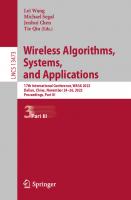
- Author / Uploaded
- Lei Wang (editor)
- Michael Segal (editor)
- Jenhui Chen (editor)
- Tie Qiu (editor)

